
views
Practicing the Correct Posture
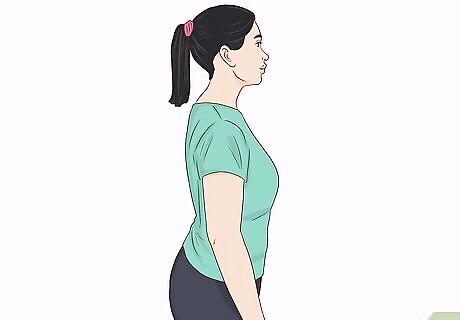
Stand upright with your chin up and your shoulders back. Don’t slouch when you’re walking in heeled wedges. Instead, keep your head and chin held up high. Bring your shoulders down and pull your shoulder blades toward each other at the back to open up the front of your chest. Keep your pelvis in a neutral position and avoid tilting it forward. If you’ll be standing still for a while, practice some comfortable standing leg poses. For instance, you could slightly bend 1 knee to take the pressure off of that foot while keeping the other leg firmly planted.
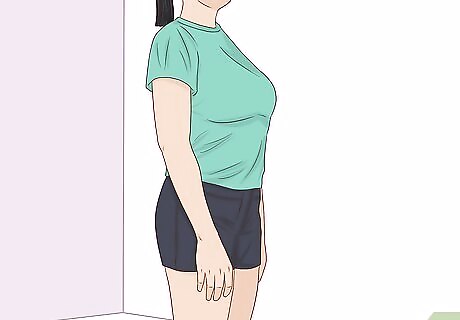
Engage your abs and leg muscles to steady your balance. Walking in wedges—especially higher-heeled ones—requires good balance. To keep yourself steady, activate your core muscles whenever you’re walking and standing in your wedges. Additionally, you’ll need to engage your thigh and calf muscles to maintain your center of gravity. Think about pulling your thigh muscles toward each other as you stand or walk in your wedges, and use your calf muscles to help keep your ankles steady. Try pilates, yoga, or a conditioning class to help build up these muscles and improve your balance.
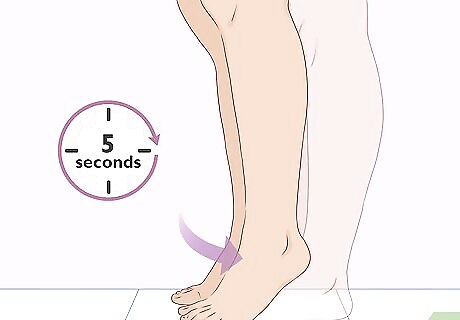
Strengthen your leg muscles by standing on the balls of your feet. As soon as you stand up in your wedges, you’ll immediately notice a different set of muscles start to engage in your legs and feet. Practice working these muscles without the shoes on. Anytime you find yourself standing around in bare feet or flat shoes, roll up onto the balls of your feet. Stay there for about 5 seconds, then slowly roll down to your heels. Once you feel comfortable doing this, try walking around on the balls of your feet. This is an easy exercise to try while you’re getting ready in the morning, waiting at a bus stop, or standing in line at the store.
Taking Steps

Hinge your front leg at the knee as you take each stride. Bend your front knee slightly as you lift your back leg off the ground, then step forward with your back foot until it's in front of the other one. Try to keep your foot pointed as you do this, and think of leading your stride with the ball of your foot. This will give you an easy, natural stride. Just keep in mind that you won’t actually plant the ball of your foot down first. Your front leg should end at about a 30-degree angle away from your body. Try this on the balls of your bare feet first before doing it in wedges. Once your leg reaches the front, don’t bend your knees and stomp. This won’t be a graceful or comfortable way to walk.

Place your heel down first, then roll through to the ball of your foot. When you have your front leg extended and your foot pointed in front of you, the heel of your wedge will be the closest part of the shoe to the ground. Continue your stride by placing the heel down first, then shift your body forward and roll through until the ball of your foot and the bottom of the wedge sits firmly on the floor. Then bring the back foot forward to take another step. Try walking in your wedges at a slow pace, to begin with. Once you find your balance, speed things up. When you’re walking in wedges, each shoe should be making a rocking motion.

Aim to place 1 foot in front of the other in a perfectly straight line. To help you maintain your balance and bring a sassy sway to your hips, think about walking along a straight imaginary line. You’ll keep your thighs and knees close together as you walk and keep your leg muscles engaged. Plant 1 foot directly in front of the other; don’t splay them out to the side. Sway your hips as you walk so you don’t put tension on your knees. Aim to keep the hip of your front leg higher and the hip of your back leg lower.
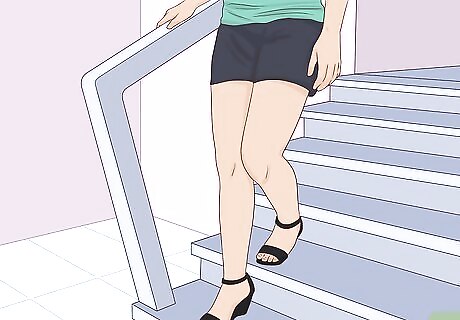
Plant your entire foot when walking up and down the stairs. If you lead with your heel while going up or down the stairs, you might take a misstep and lose your balance. Avoid this by planting the whole base of the shoe firmly on each step. Make sure you feel steady on your foot before taking the next step. Hold onto the handrail and take the stairs slowly so you don’t lose your balance.
Selecting a Good Pair of Wedges
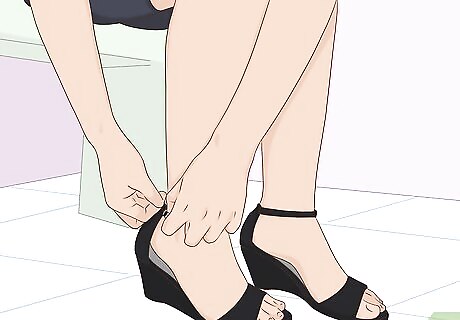
Choose wedges that fit your feet snugly without pinching. When you try on a new pair of wedges, make sure the ball of your foot sits comfortably on the widest part of the shoe. For a closed-toe pair, wiggle your toes to make sure the toe box isn’t constricting. Or, for open-toe wedges, check to make sure your toes don’t extend past the edges of the sole. Ensure that they sit comfortably on the sole without getting pinched by the straps. Any pinching or rubbing will result in a blister, so it’s important that the shoes fit comfortably. Try an open-toe style to give your toes and feet more space to breathe.
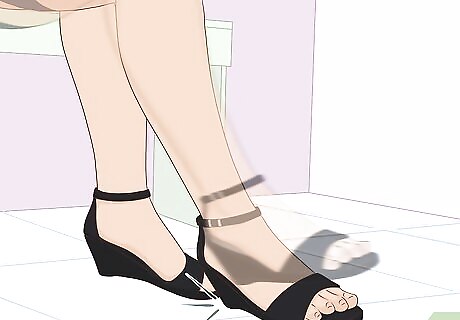
Tap on the wedges to see if the base of the shoe is stable. When you’re considering a pair of wedges, set both shoes on a flat surface. Then, gently tap on the back part of the shoe, where your ankle would be. If the wedges teeter around or topple over, they won’t be easy or safe to walk in. Try to find a wedge that stays in place went you nudge it. Look for a wedge with a wider base for greater stability. If the shoe’s footprint is about the size of your foot, it should be pretty secure. But if the footprint is significantly smaller, it won’t be as stable.
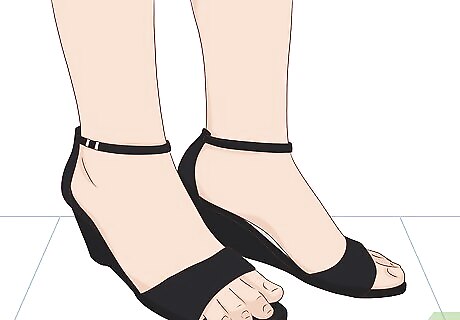
Opt for wedges with an ankle strap for more stability. Wedges come in an endless variety of styles, from classic slingbacks and lace-up espadrilles to chunky styles with thick velcro straps. For the most comfortable walking experience, choose wedges that offer some sort of ankle strap for additional support. Make sure the shoe has an adjustable closure like a buckle so you can get a custom fit. Alternatively, try wedges with a side or back zip closure that hold your foot in a “cage” of straps. If they fit properly, these can feel very secure, too. Avoid wrapping straps or ties too tightly around your ankle as they might put pressure on your Achilles' tendon. If you’re new to wedges, avoid mules or flip-flop wedges that don’t have any sort of ankle strap. They’ll put a strain on your toes to grip onto the shoe. Plus, your foot might slip out of the shoe, causing you to twist your ankle.

Aim for a heel height of 3 in (7.6 cm) or lower if you plan to do a lot of walking. The right wedge can actually be a great everyday walking shoe. Stick with heel heights below 3 in (7.6 cm) so your foot doesn’t sit at a steep angle. If you prefer taller heels, look for wedges with a platform beneath the toe area. Even a slight platform will make the slope of your foot less dramatic. Choose wedges with grippy, slip-resistant bottoms if you’ll be walking a lot. Try a shoe with a base made out of raffia, cork, or a squishier synthetic material. Wood and hard plastic bottoms won’t be as shock-absorbent. If you plan to do a lot of walking in your wedges, look for a shoe with a cushioned sole or add an insole to an existing pair of wedges.
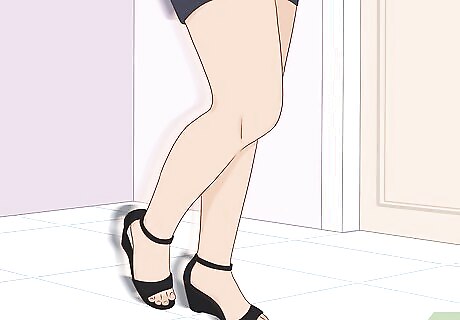
Break in your wedges by walking around in them at home. Soften up a brand new pair of wedges before going out in them to make them more comfortable. When you’re at home, wander around in your new shoes for a few hours at a time. Make sure you take them up and down the stairs and wear them on a variety of hard and soft floor surfaces to get more practice. When you’re starting to feel comfortable in your new shoes, try wearing them for a brisk 10- to 20-minute walk to make sure they don’t rub your feet in any way. If you notice some tender places, put an adhesive bandage over that part of your foot to prevent a blister from forming. Consider slipping a pair of comfortable flats into your bag the first time you go out in your wedges. This way, you can change if they start to become uncomfortable.
















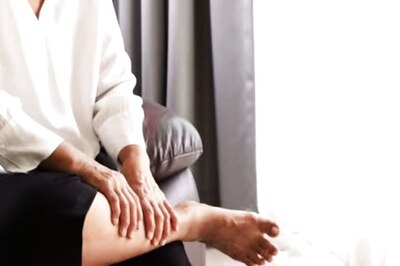



Comments
0 comment